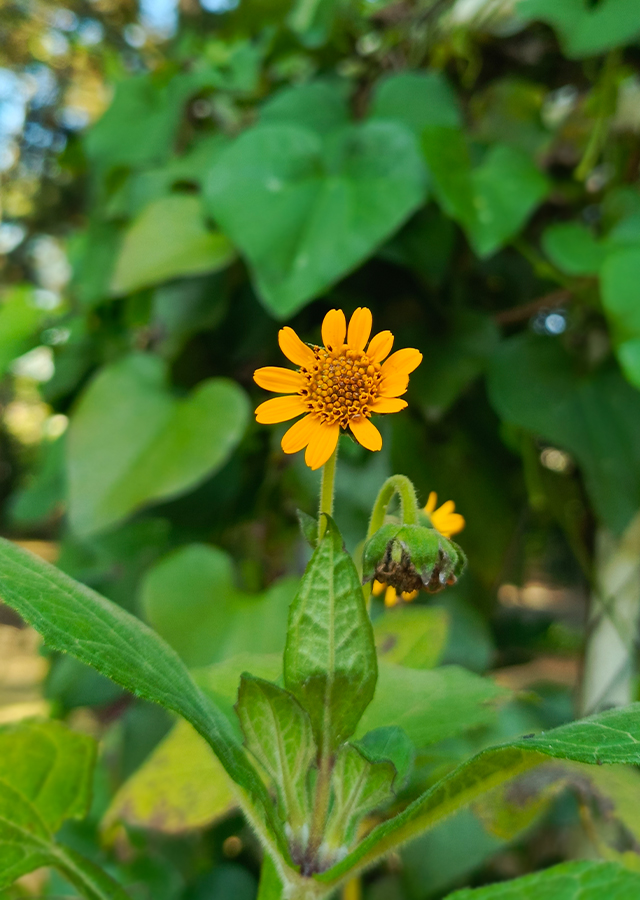Yacon
Smallanthus sonchifolius (Poepp.) H.Rob.
Asteraceae
Location in our garden
Shading Area



Synonym
Polymnia edulis Wedd.
Polymnia sonchifolia Poepp.
Silphium edule Baill.
Habitus
Herbaceous. A herbaceous perennial plant growing from a tuberous rootstock around 2 m tall
Part Used
Leaves
Tuber
Growing Requirements
Full Sunshine
Need Shade
Habitat
Shrublands
Grassland
Terrestrial
Overview
Yacon is a member of the sunflower family, native to the lower Peruvian Andes and many South American forest regions, and long valued as a root crop. It was first recorded as a native cultivated root crop by the Andeans in 1615. Yacon has been cultivated and consumed since the pre-Incan period. It might have been neglected because of its low nutritive value. It surfaced into the scientific community only in the 1980s. With its health benefits spreading through the grapevine of nutraceuticals, its growth and cultivation has spread widely, in several countries, like Czech Republic, China, Brazil, Japan, Italy, New Zealand. Fresh tubers are crisp and juicy redolent of apples and melons, sometimes referred to as "Apple of the Earth." It has a sweetness that increases with storage. Eaten raw, baked, roasted, jammed, juiced into syrup or drinks, or made into pudding dishes. The root can be eaten like a fruit or diced and added to salads. The grated pulp of the root is squeezed through a cloth to yield a sweet refreshing drink. This juice can be concentrated to form dark brown blocks of sugar called 'chancaca' in South America. Leaves and stems are cooked as a vegetable.
Vernacular Names
Poire de terre (French), Arboloco (Spanish), Jíkima (Venezuela), Jiquimilla (Colombia), Yaakon (Japanese), Ya gen (Chinese).
Agroecology
A plant of higher elevations in the tropics, where it is found at elevations up to to 3,600 m. It grows best in areas where annual daytime temperatures are within the range 12-22 °C, but can tolerate 5-30 °C. Top growth is killed by frost, but the dormant tuber can tolerate temperatures at least a little below freezing. The plant prefers a mean annual rainfall in the range 800-1,200 mm, but tolerates 600-1,400 mm. Succeeds in full sun and in light shade. For best results, this plant requires a warm position in a deep rich soil, though it survives even when growing in poor soils. Prefers a pH in the range 5.5-6.5, tolerating 5-7.
Morphology
- Root - edible, fleshy, yellowish white, sweet, with a crisp consistency of sinkamas.
- Leaves - opposite, broadly ovate with widely toothed margins and extending into the stems.
- Flowers - daisy-like, yellow to orange, avidly pollinated by insects.
Cultivation
- Generative propagation is by seed - sow in containers in a nursery and only just cover the seed. Prick out the seedlings into individual pots as soon as they are large enough to handle and plant them out when 15 cm or more tall.
- Vegetative propagation is by division - when the plant is dormant. The plant forms 2 distinct types of tuber. Large tubers, usually on thin roots 2-5 cm long, are used as storage organs and do not have the capacity to form new shoots. These are the tubers that are usually eaten. Smaller tubers are formed in a cluster around the stem. These form the shoots for the following year's growth and so are the ones that should be used for propagation. Also propagated by cuttings of basal shoots.
Chemical Constituents
Protocatechuic, chlorogenic, caffeic and ferulic acids, terpenoids, triterpenoids, monoterpenes, sesquiterpenes (sonchifolin), diterpenes, oligofructans, polyphenols, melampolides (polymatin B, uvedalin and enhydrin), alkaloids, and many others.
Traditional Medicinal Uses
- Studies have suggested antioxidant, cytoprotective, antidiabetic, prebiotic, antimicrobial, hepatoprotective, trypanocidal, antiteratogenic, anti-inflammatory, hypolipidemic, immunomodulatory properties.
- In Japan and Brazil, aerial parts used as components of medicinal tea.
- Decoction of leaves is used as tea for diabetics in Brazil.
- In South America, the raw tubers as a diuretic for kidney and bladder problems.
- In Bolivia, decoction of leaves is used for cystitis, hepatosis and nephrosis.
- In Peru, warm poultice of leaves is used for myalgias and rheumatism.
Part Used
Reference Sources
- Fern, Ken. (2021). Tropical Plants Database: Smallanthus sonchifolius. https://tropical.theferns.info/viewtropical.php?id=Smallanthus+sonchifolius&redir=Polymnia+edulis. 17-06-2022.
- Kew Royal Botanic Gardens. (No date). Plants of the World Online: Smallanthus sonchifolius (Poepp.) H.Rob. https://powo.science.kew.org/taxon/urn:lsid:ipni.org:names:237510-2. 17-06-2022.
- Stuartxchange. (2020). Philippine Medicinal Plants: Yacon. http://www.stuartxchange.org/Yacon. 17-06-2022.
- J. Lachman, E.C. Fernández, M. Orsák. (2003). Yacon [Smallanthus sonchifolia (Poepp. et Endl.) H. Robinson]
chemical composition and use – a review. Plant, Soil and Environment, 49(6): 283–290.

